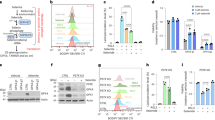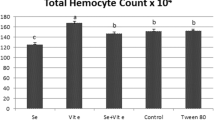Abstract
RESEARCH on the biochemical function of trace selenium in animal nutrition indicates it probably functions in lipid antioxidant and free radical acceptor reactions. Selenoprotein fractions from selenate-fed animals have up to 500 times the antioxidant activity of vitamin E (ref. 1). Selenoamino-acids were very effective in reducing free-radical damage to enzymes and amino-acids when aqueous solutions were exposed to ionizing radiation2. Woodbridge3 found organic selenium compounds to be powerful antioxidant agents. These unusual properties of selenium compounds in reacting with free radicals suggested that an electron paramagnetic resonance investigation of selenium amino-acids and antioxidants and their sulphur analogues would be of interest.
This is a preview of subscription content, access via your institution
Access options
Subscribe to this journal
Receive 51 print issues and online access
$199.00 per year
only $3.90 per issue
Buy this article
- Purchase on Springer Link
- Instant access to full article PDF
Prices may be subject to local taxes which are calculated during checkout
Similar content being viewed by others
References
Hamilton, J. W., and Tappel, A. L., J. Nutr., 79, 493 (1963).
Shimazu, F., and Tappel, A. L., Science, 143, 369 (1964).
Woodbridge, D. T., M.Sc. thesis, Univ. London (1959).
Author information
Authors and Affiliations
Rights and permissions
About this article
Cite this article
WINDLE, J., WIERSEMA, A. & TAPPEL, A. Free Radicals from Selenium and Sulphur Antioxidants. Nature 203, 404–405 (1964). https://doi.org/10.1038/203404a0
Issue Date:
DOI: https://doi.org/10.1038/203404a0
This article is cited by
-
Epr studies of radicals in conducting solutions, oligomer crystals and conducting polymers
Reviews of Chemical Intermediates (1986)
Comments
By submitting a comment you agree to abide by our Terms and Community Guidelines. If you find something abusive or that does not comply with our terms or guidelines please flag it as inappropriate.



